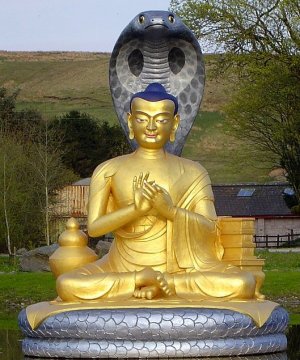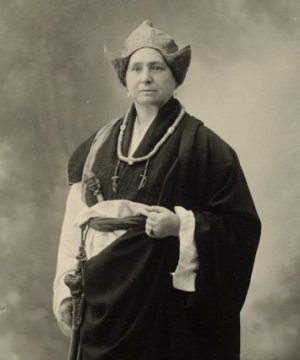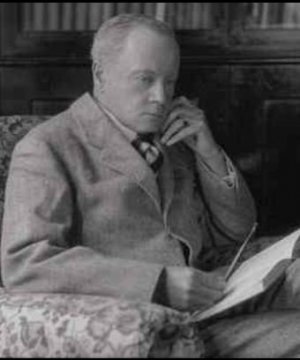| Library / Biographies |
Ralph T. H. Griffith Biography
Ralph Thomas Hotchkin Griffith (1826–1906) was an English Indologist, a member of the Indian education service and among the first Europeans to translate the Vedas into English. He lived in the UK (Oxford) and in India (Benares and Nilgiris).
Griffith was born at Corsley, Wiltshire, on 25 May 1826. Was son of Robert Clavey Griffith (1792-1844), rector of Corsley (1815-44) and of Fifield Bavant, also in Wiltshire (1825-44), by his wife Mary Elizabeth Adderly, daughter of Ralph Hotchkin of Uppingham Hall.
Educated first at Westminster school and then at Uppingham, Ralph proceeded with an exhibition from Uppingham to Queen's College, Oxford, which he entered as a commoner on 16 March 1843. Obtaining an honorary fourth class in classics, he graduated B.A. on 29 Oct. 1846, and proceeded M.A. on 22 June 1849.
At Oxford he became a pupil of Professor Horace Hayman Wilson [q. v.], and gaining the Boden Sanskrit scholarship in 1849, continued the study of Sanskrit to the end of his life. From 1850 to 1853 he was assistant master of Marlborough College, of which he was also librarian.
In 1853 he joined the Indian educational service, and on 17 December became professor of English literature at the Benares Government College. His promotion was rapid: on 1 June 1854 he became headmaster of the college. He encouraged sport, and showed thorough sympathy with Indian students.
In the following year he was entrusted, in addition to his other duties, with the charge of the Anglo-Sanskrit department; and in 1866 he was appointed inspector of schools in the Benares circle.
During his first eight years in India (1853-61) Griffith devoted himself not only to the study of Sanskrit but to that of Hindi, the most widely spoken vernacular of northern India, under Pandit Ram Jason, the head Sanskrit teacher of the college, to whom he was much attached.
On the retirement of James Robert Ballantyne [q. v.] in 1861 Griffith succeeded to the principalship of the Benares College. He held the post for seventeen years, in the course of which he acted three times for short periods as director of public instruction.
On 15 March 1878 he left the Benares College after a quarter of a century's service, and from that date till 1885 was director of public instruction in the North-west Provinces and Oudh.
His success in official life, both as an administrator and a teacher, was uninterrupted. On his retirement he received a special pension, the honour of C.I.E., and the thanks of the government.
Calcutta University made him a fellow. Unmarried and without close family ties in England, Griffith, after reaching India in 1853, never saw his native country again.
On his retirement he withdrew to Kotagiri, a beautiful hill station, some 7000 feet high, in the Nilgiris district, Madras, residing with his brother Frank, an engineer in the public works department of the Bombay presidency, who had settled there in 1879. At Kotagiri he tranquilly engaged in the study and translation of the Vedas. He died on 7 November 1906, and was buried there.
Griffith was attracted by the literary rather than by the linguistic side of Sanskrit. But he rendered a great service to the direct study of the language by founding in 1866 the 'Pandit,' a monthly journal of the Benares College, devoted to Sanskrit literature. This he edited for eight years. More than forty annual volumes have already appeared.
To the translation of Sanskrit poetry Griffith devoted himself for nearly half a century. He began at Marlborough College with his ‘Specimens of Old Indian Poetry’ (1852), containing selections tastefully translated in various rhyming metres from the two great epics, the ‘Mahābhārata’ and the ‘Rāmāyana,’ and from the works of India's greatest poet, Kālidāsa.
An extract from the drama ‘Śakuntalā’ is in blank verse. At Marlborough also he made a translation in heroic couplets of Kālidāsa's court epic, the ‘Kumāra-sambhava,’ under the title of ‘The Birth of the War-god’ (1853; 2nd edit. 1879).
There followed ‘Idylls from the Sanskrit’ (1866), selections similar to those in his first book, and ‘Scenes from the Rámáyan’ (1868). His translation of the whole epic, the ‘Rámáyan of Válmíki,’ in rhyming octosyllabic couplets, occasionally varied by other metres was completed in five volumes (1870–5).
Having paid some attention to the study of Persian, he published in 1882 a version of ‘Yuzuf and Zuleika,’ which was his only excursion in translation outside Sanskrit.
After his retirement to the Nīlgiri Hills, Griffith turned from classical Sanskrit to the sacred scriptures of the Hindus, the Vedas.
The ‘Rigveda’ or Veda of hymns, which represent the higher religion of the ancient Indo-Aryans, appeared in a verse translation entitled ‘Hymns of the Rigveda, with a Popular Commentary,’ in four volumes (Benares, 1889–92; 2nd edit. 2 vols. 1896–7).
There followed the ‘Hymns of the Sāmaveda,’ or Veda of chants concerned with the Soma ritual (Benares, 1893); the ‘Hymns of the Atharvaveda,’ or Veda mainly consisting of magical spells (2 vols. Benares, 1895–6), and finally ‘The Texts of the White Yajurveda,’ or sacrificial Veda (Benares, 1899).
In these translations Griffith abandoned rhyme and rendered each verse by one syllabically harmonising with the original and generally divided into corresponding hemistichs. Griffith's command of poetical diction enabled him to reproduce the form and spirit of the ancient hymns better than by means of prose or of rhyming verse.
His translation of the Rigveda follows the text of Max Müller's six-volume Sanskrit edition. His readings generally follow the work of the great scholar Sayana, who was Prime Minister at the court of the King of Vijaynagar in what is now the District of Bellary in the Indian state of Karnataka during the fourteenth century.
Works
• The Ramayan of Valmiki (published 1870)
• Hymns of the Rigveda (published 1889)
• Hymns of the Samaveda (published 1893)
• Hymns of the Atharvaveda (published 1896)
• The Texts of the White Yajurveda (published 1899) (Wikipedia)





